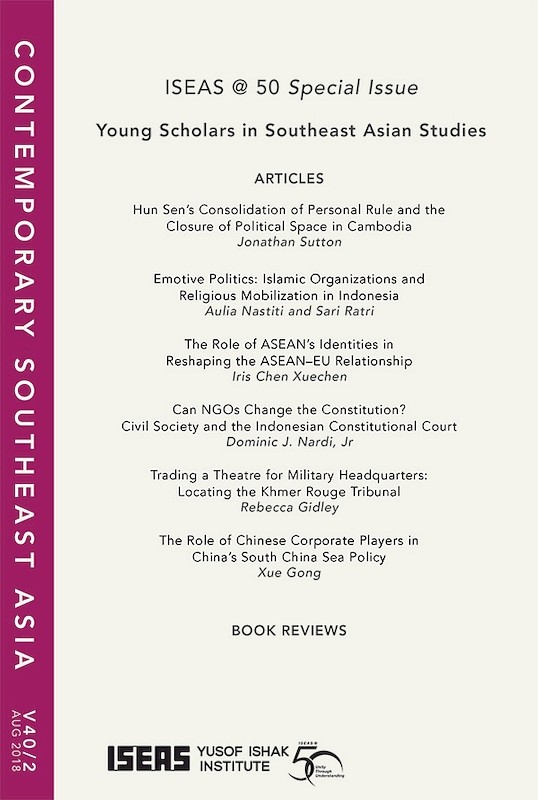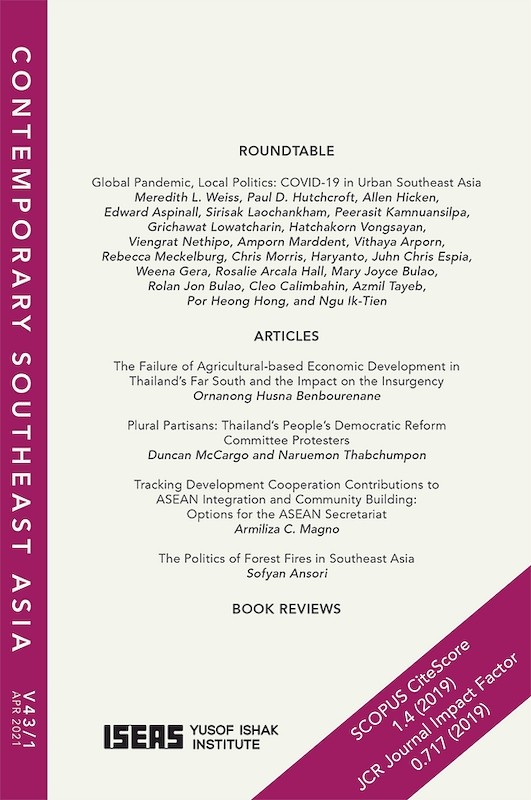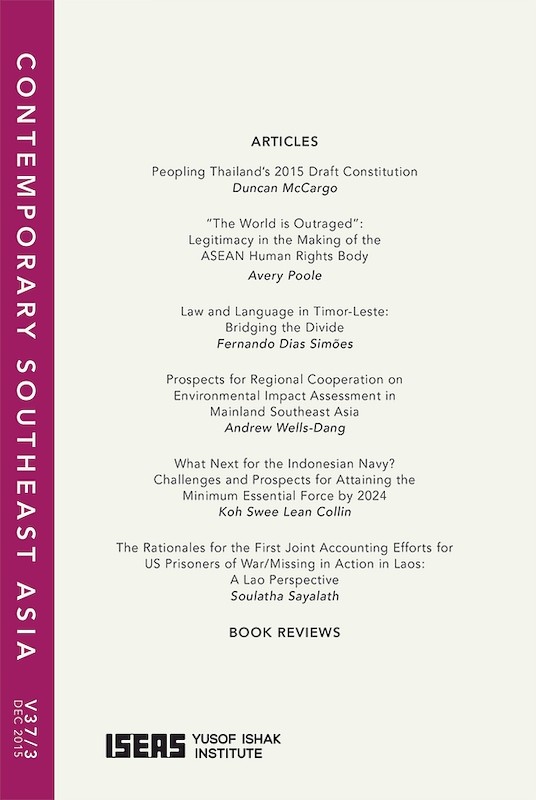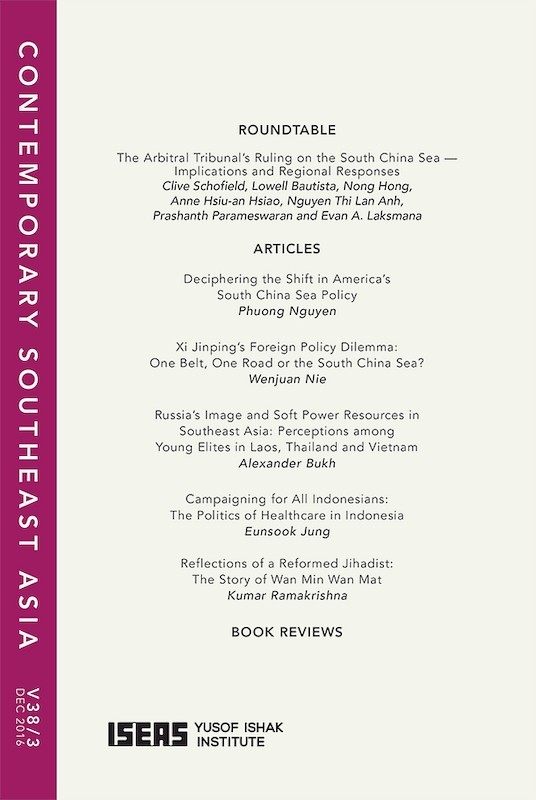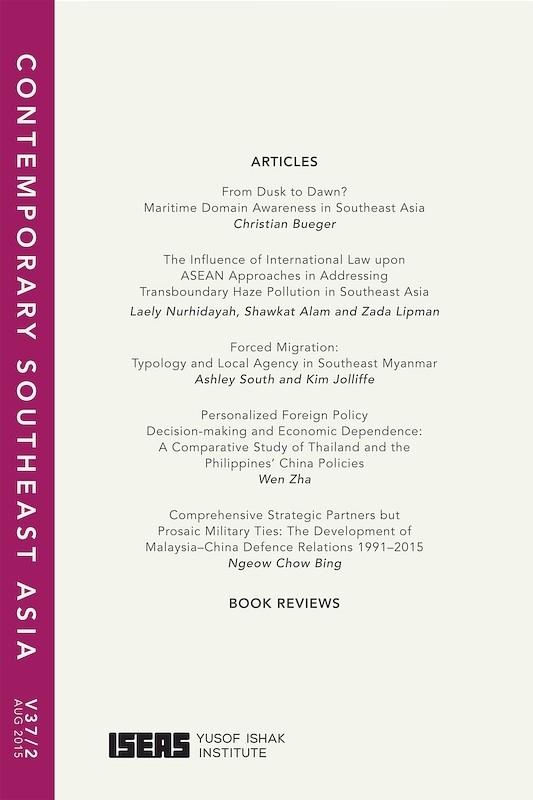Contemporary Southeast Asia Vol. 38/1 (April 2016)
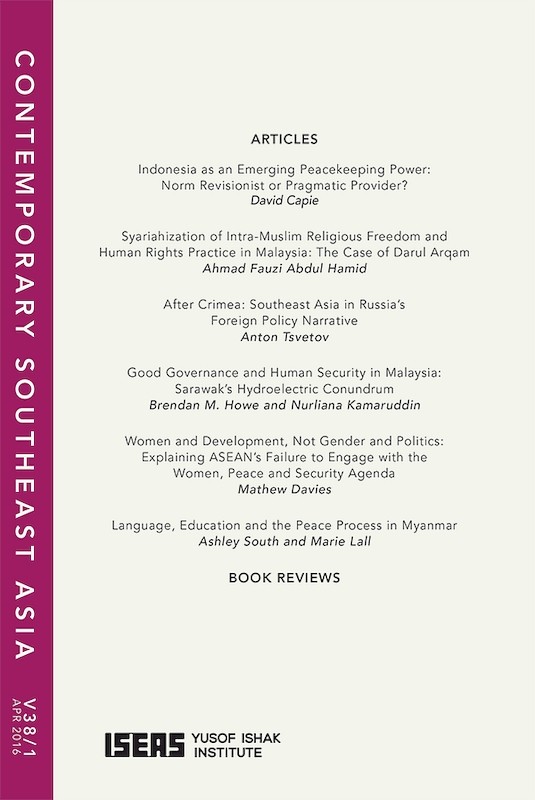
Ian Storey, editor
Date of publication:
April 2016
Publisher:
ISEAS – Yusof Ishak Institute
Number of pages:
176
Code:
CS38/1
About the publication
- Attained impact factor of 0.906 in Social Sciences Citation Index 2017
- Ranked 18th by Google Scholar Metrics 2018 in the Asian Studies and History category
Contents
-
Contemporary Southeast Asia Vol. 38/1 (April 2016)
[Whole Publication, ISSN: 1793284X] -
Preliminary pages
- ARTICLES
-
1. Indonesia as an Emerging Peacekeeping Power: Norm Revisionist or Pragmatic Provider?, by David Capie, author see abstractIndonesia is frequently mentioned as an emerging player in United Nations (UN) peacekeeping, but its role has been understudied compared to other emerging powers. Drawing on interviews with foreign and defence ministry officials, and independent analysts in Jakarta, as well as statements by Indonesian representatives in the UN and other forums, this article makes three arguments. First, although Indonesia has a long history of involvement in UN peacekeeping operations (PKOs), there has been a major change in policy in the last decade, with much greater importance attached to peacekeeping. Jakarta has set itself the goal of becoming a top ten troop contributing country with 4,000 personnel deployed by 2019. Second, although Indonesia retains a strong preference for traditional “blue helmet” missions mandated by the UN Security Council (UNSC), and based on principles of host country consent, impartiality and non-use of force, its views on peacekeeping are evolving. While Indonesia has concerns about aspects of the “new” peacekeeping agenda, such as Protection of Civilians and robust peace enforcement missions, in practice it has proved to be more pragmatic than some of its rhetoric might suggest. Third, although emerging powers are frequently portrayed as conservative, Indonesia has been an advocate for a more ambitious approach to peacekeeping in Southeast Asia. It was the first to argue for an ASEAN peacekeeping force and has supported the use of regional troops to monitor peace agreements. In sum, the Indonesian case supports some of the claims made about emerging powers and peace operations but challenges others, underlining the diversity of this group of states.
-
2. Syariahization of Intra-Muslim Religious Freedom and Human Rights Practice in Malaysia: The Case of Darul Arqam, by Ahmad Fauzi Abdul Hamid, author see abstractIslam was officially installed as the religion of the Federation of Malaya upon independence on 31 August 1957, and retained as such after the formation of Malaysia on 16 September 1963. Since then, political stakeholders have not shied away from making the most of Islamic symbols, practices and institutions towards achieving national economic development or regime maintenance. Driven by hegemonic considerations, they largely ignored intra-Muslim religious variations. The religious uniformity of Malays, all of whom were Muslims by law, was literally taken for granted and served as a politically expedient vehicle for Islamic-based political mobilization by the Malay-dominated regime. Pluralist conceptions of Malaysian society were accepted only insofar as they pertained to Muslim-non-Muslim distinctions. At the core of the government’s efforts to infuse the Malaysian polity with Islamic alternatives for socio-political arrangements is a gradual process of syariahization. However, owing to arbitrary interpretations of the syariah (Islamic law) by Malaysia’s official Islamic gatekeepers, syariahization resulted in state-manufactured denial of freedom of religious expression to non-conformist Malay-Muslims. Until today, Muslim non-conformists are not allowed to adopt, let alone to propagate, different forms of Islam that run afoul of the version upheld by an officially sanctioned version of the syariah. As reflected by the case of the Sufi-inspired Darul Arqam movement, government-imposed syariahization has resulted in the violation of fundamental human rights of Malay-Muslims, regardless of the fact that the syariah itself may not have been clear-cut in determining the boundaries between religious orthodoxy and unorthodoxy in prescribing punishments for dissent. <br>
-
3. After Crimea: Southeast Asia in Russia's Foreign Policy Narrative, by Anton Tsvetov, author see abstractThe deterioration of Russia’s relations with the West over the Crimea in 2014, and the ongoing crisis in the Ukraine, has led to a new emphasis on the Asia Pacific in the country’s foreign policy. However, it remains a matter of debate whether Russia’s “pivot to the East” represents a fundamental strategic shift or merely a tactical geopolitical manoeuver. In addition, it remains open to question whether Russia’s Asian pivot encompasses countries across the region other than just China which remains at the heart of the Kremlin’s Asia-Pacific policy. This article examines Southeast Asia in current Russian foreign policy and strategic thinking, assesses Russia’s stance towards the region with regard to bilateral ties and multilateral mechanisms and presents an outline of the future development of Russia’s engagement with Southeast Asia. The arguments put forward in the article suggest that Southeast Asia is at least secondary to China within the Asian pivot, while the pivot itself is at least secondary within Russia’s overall foreign policy. The main value of Southeast Asia for Moscow lies in its image-building strategy, with the West as the primary audience. We can therefore assume that there is unlikely to be any groundbreaking developments in Russia’s relations with Southeast Asia for the foreseeable future, although the former will welcome cooperative initiatives from the latter. <br>
-
4. Good Governance and Human Security in Malaysia: Sarawak's Hydroelectric Conundrum, by Brendan M. Howe, Nurliana Kamaruddin, authors see abstractGood governance is an essentially contested concept. In Asian countries, economic efficiency and macro-economic projects have predominantly been pursued with the aim of promoting national, aggregate measurements of development. Hydroelectric power generation projects have played a central role in the national planning of several regional states as part of an attempt to achieve these goals. Even by their own terms of reference, however, hydroelectric power projects have at most a mixed record of success, and are increasingly criticized with regard to their negative impact on the environment, and upon vulnerable groups. The government of Malaysia has embraced the “developmental state” model, and this is best illustrated by governance initiatives and resource exploitation in the East Malaysian states of Sarawak and Sabah and their respective “development corridors”. Sarawak’s Corridor of Renewable Energy (SCORE) is the most visible sign of Malaysia’s macro-economic hydroelectric development focus, as Sabah’s corridor focuses on trade, investment, and tourism. This article takes a critical perspective towards good governance, emphasizing that it should function in the interests of all society, but in particular the most vulnerable. It therefore addresses the impact of Malaysian hydroelectric development policies on one of the most vulnerable sections of Malaysian society, the indigenous peoples of Sarawak. The findings cast doubt on the validity of continued prioritization of hydroelectric dam construction as a cornerstone of government energy and development policy.
-
5. Women and Development, Not Gender and Politics: Explaining ASEAN's Failure to Engage with the Women, Peace and Security Agenda, by Mathew Davies, author see abstractWhile questions have been asked about whether ASEAN could, or even should, adopt the United Nation’s Women Peace and Security (WPS) agenda, this article is the first to ask why it has not done so already. ASEAN’s strong engagement with gender issues beyond the WPS agenda, together with the pressing need to address conflict and security concerns within Southeast Asia, make this an absence that requires an explanation. I argue that the usual explanatory framework deployed to account for ASEAN “not doing” something — the weaknesses caused by consensus, unanimity and the “ASEAN Way” — do not explain the absence of the WPS agenda; ASEAN’s engagement with gender is too advanced for the “it does not want to” explanation to hold. Instead, I locate the failure to engage with the WPS agenda in a particular elite understanding of women as both non-political and vehicles for the realization of economic and social well-being. This elite mindset, which both differs from that found within the ASEAN institutions dedicated to gender issues and which serves as the key driver of ASEAN’s institutional design, has retarded engagement with WPS because it stands at odds with the active political agency of women that WPS promotes. Revealing this reason for ASEAN’s failure to institutionalize WPS provides a way to consider the future of this important set of norms. I argue that efforts to mainstream WPS must take account of this ingrained framing of women as apolitical if they are to be successful.
-
6. Language, Education and the Peace Process in Myanmar, by Ashley South, Marie Lall, authors see abstractThis article analyses the relationship between the politics of education and language, and armed conflict and ongoing peace process in Myanmar. It discusses the state education system, which since the military coup of 1962 has promoted the idea of the country based on the language and culture of the Bamar (Burman) majority community, and the school systems developed by ethnic armed groups which oppose the military government. Ethnic opposition education regimes have developed mother tongue-based school systems. In some cases, the Mon for example, these broadly follow the government curriculum, while being locally owned and delivered in ethnic languages; in others, such as the Karen, the local education system diverges significantly from the Myanmar government curriculum, making it difficult for students to transition between the two systems. This article explores the consequences of these developments, and how reforms in Myanmar since 2011 — including the peace process, which remains incomplete and contested — have opened the space for educational reform, and the possible “convergence” of state and non-state education regimes. Ethnic nationality communities remain determined to conserve and <br>reproduce their own languages and cultures, adopting positions in relation to language and education which reflect broader state-society relations in Myanmar, and in particular ethnic politicians’ demands for a federal political settlement to decades of armed conflict. The article concludes that sustainable resolution to Myanmar’s protracted state-society conflict is unlikely to be achieved until elites can negotiate agreement on ethnic language and teaching policies. <br>
- BOOK REVIEWS
-
BOOK REVIEW: The ASEAN Regional Security Partnership: Strengths and Limits of a Cooperative System. By Angela Pennisi di Floristella, by Shaun Narine, author
-
BOOK REVIEWS: Law, Society and Transition in Myanmar. Edited by Melissa Crouch and Tim Lindsey; Metamorphosis: Studies in Social and Political Change in Myanmar. Edited by Renaud Egreteau and Francois Robinne, by Moe Thuzar, author
-
BOOK REVIEW: The ASEAN Charter: A Commentary. By Walter Woon, by Kasira Cheeppensook, author
-
BOOK REVIEW: Blood, Dreams and Gold: The Changing Face of Burma. By Richard Cockett, by Sean Turnell, author
-
BOOK REVIEW: China-Malaysia Relations and Foreign Policy. By Abdul Razak Baginda, by Mustafa Izzuddin, author
-
BOOK REVIEW: Southeast Asia Energy Transitions: Between Modernity and Substainability. By Mattijs Smits, by Christopher Len, author
-
BOOK REVIEW: Bridging Troubled Waters: China, Japan, and Maritime Order in the East China Sea. By James Manicom, by Lowell Bautista, author

